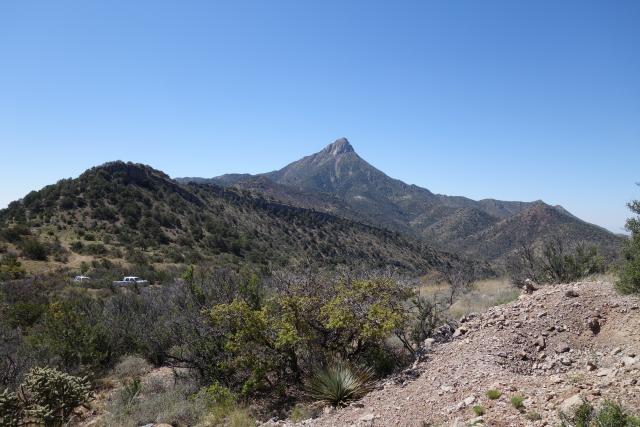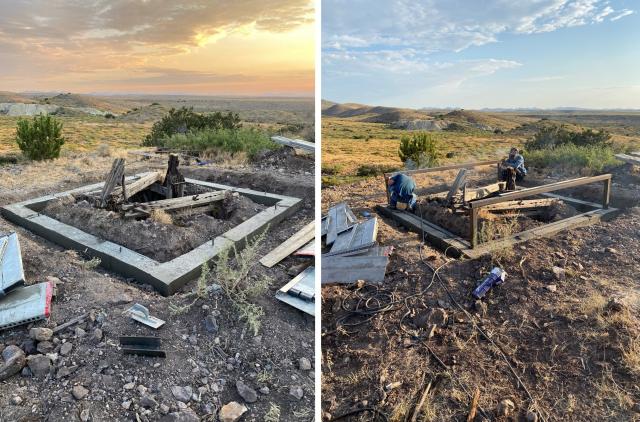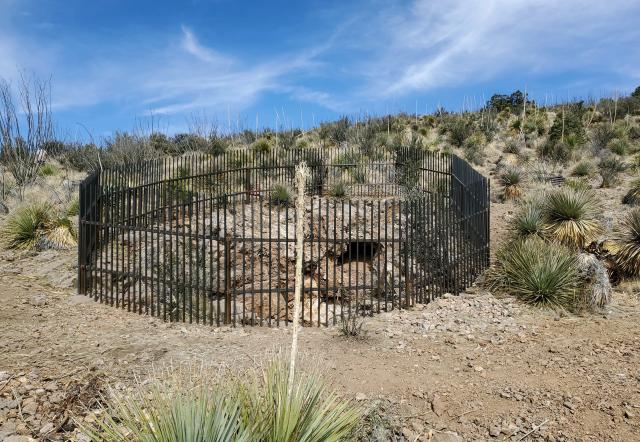You are viewing ARCHIVED content published online before January 20, 2025. Please note that this content is NOT UPDATED, and links may not work. Additionally, any previously issued diversity, equity, inclusion or gender-related guidance on this webpage should be considered rescinded. For current information, visit https://www.blm.gov/blog.
PODCAST: Cleaning up abandoned mine lands yields wildlife benefits in southwest New Mexico


Click PLAY to listen
In the southwestern corner of New Mexico, the Bureau of Land Management is closing more than 300 mine features -- adits, shafts and other open spaces. Frequently hidden from view, these sites were abandoned years ago and can be dangerous for humans unfamiliar with the area where they are located. Some of these features also provide a glimpse into the nation's mining history.
Simply closing mines is not a blanket solution. Some of these are home to animal species like the Mexican long-nosed bat -- also called the greater long-nosed bat -- a small species that was listed as endangered by the U.S. Fish & Wildlife Service in 1988. While the process of closing the mine features has been ongoing since 2016, BLM received funding through the Bipartisan Infrastructure Law in 2022 to restore the abandoned mine lands. For Physical Scientist Chris Teske, this involves improving the bat habitat as well as making the area safer.

TRANSCRIPT: Cleaning up abandoned mine lands yields wildlife benefits in southwest New Mexico
In a remote part of southwestern New Mexico, the Bureau of Land Management is restoring an area to both protect people from dangerous mine shafts and to improve the habitat for endangered species.
I’m David Howell, and you’re listening to On The Ground, A Bureau of Land Management Podcast. Chris Teske is a physical scientist in charge of cleaning up mine adits and shafts in the Cookes Peak Range, west of Las Cruces, New Mexico. The mines were abandoned by private operators many years ago, but still presented a danger to the public. Congress provides funding every year for making abandoned mines less dangerous, but the 2021 Bipartisan Infrastructure Law provided additional funds for mine land restoration – to help erase or reduce the visibility of the mines from the landscape. And as I sat down with Chris, he surprised me right off the bat when he described the volume of work at the site.
CHRIS TESKE, PHYSICAL SCIENTIST, BLM NEW MEXICO: Cookes Peak Range was a mine for silver, and then they would ship their silver to a little mill site called Lake Valley, which is probably 40 miles away. In total on Cookes, we did 320 mine closures, but not all 320 were related to BIL funding. It was just that…
DAVID HOWELL, INTERVIEWER: Sorry, did you say 320 mines?
TESKE: Yeah, mining features, yeah.
HOWELL: Holy cow! So these were individual holes they drilled?
TESKE: Yeah, adits, shafts, some stopes that had opened up. So we did seven phases: six regular phases and then the BIL funding phase at the end of it. 2016 was the beginning of the phases for our regular mine closures.
HOWELL: Wow. OK, so you've been working on this for about eight years, then.
HOWELL: Yeah, yeah. But it's a really pretty mountain range. It's kind of rough, the roads getting up to the top, but once you get there, it is really an amazing view from up there.
HOWELL: That's great. Backing up just a little bit, my understanding is that this mine was abandoned, right?
TESKE: Yes, they were all abandoned.
HOWELL: OK, so what does an abandoned mine then mean for the federal government?
TESKE: So all these open holes on the range with all the public, you know, going out and recreating more actually has increased the chance of people getting you know injured or killed. Luckily, we haven't had that many: the last fatality on a mine site in New Mexico was in 2020. Cookes Range, we hadn't had any fatalities, but with the increased visitation, it was going to happen.
HOWELL: So BLM’s regular abandoned mine land program funding that comes from Congress -- that's mostly just to address the holes in the ground, block them up so that they don't pose a public health or safety hazard?
TESKE: Right, right. Unless it's something real major, we don't get back into the reseeding of them at that point. Where the BIL funding actually helped out was, we actually reseeded the roads that actually went into the sites, so you can't even tell where the roads were that went back into some of these sites anymore.

HOWELL: So… OK, so you got these 300 mine features that you're that you've been working on. Bipartisan Infrastructure Law funding, as I understand it, has been aimed at trying to not just deal with the closures, which you have been, but also to restore the land, right?
TESKE: Yep, and the BIL part was just to close some features, the few remaining, and then we reseeded grass to all the sites. And then our last portion of it here in February was to plant agave because this is Mexican long nosed bat territory. So we actually planted agave to enhance their range. And that's a threatened bat also.
HOWELL: Oh, so they need the agave to you know, as.. for their sustenance, I guess.
TESKE: Yes, yes. Because they're nectar feeding bats, so they would use the agave once they bloom. So it was it was threefold, you know, what we did: we wanted to enhance their habitat, and then we also enhanced other wildlife habitat with the reseeding and everything.
HOWELL: Wow, okay – that’s fantastic! So is the project done at this point, then?
TESKE: Almost. I want to go in and do another phase of agave on the east side of the mountain. We did 300 plants on the agave on the west side of the range, and then I'm gonna go in and do another 300 agave plants on the east side.
HOWELL:
So what do you hope that somebody coming and driving that area is going to see or not see, maybe, 10 years from now?
TESKE: What I would like them to see is that there's not pronounced erosion. A lot of times the erosion starts from the old mining roads and old mining trails, and the way we went about mitigating that was reestablishing the vegetation on those. I believe we won't see the major rilling and cutting from erosion in the next 10 years.
HOWELL: That's maybe one of the other hazards, the natural hazards that happens as a result of mining in that area?
TESKE: Yeah. Because those roads give you a channel for that water to flow down so fast. So when we mitigate them, you remove that energy of the water, then it's more controllable; you kind of kick it to overland flow at that point. When that road is “re-veg’ed,” then that spreads that water out, down the hillside, not just channel it.
HOWELL: Takes the energy out of it and then it doesn't wear away the soil. That's fantastic.
TESKE: Yeah.
HOWELL: So this project has been ongoing for quite a long time, longer than the 8 years of just the treatment.
TESKE: Oh, yeah – it was several years prior to that, the cultural studies, wildlife studies. A lot of people don't understand how much work goes into one of the projects, you know.
HOWELL: Yeah, I was gonna say -- you're taking a very holistic look at this from a lot of different scientific disciplines.
TESKE: Oh yeah. There's other things -- I want to do wildlife waters up on this site too, and we've coordinated with our wildlife people. That's what I want to do: finish out on Cookes with two wildlife waters, one on the east side and one on the west.
HOWELL: And so, besides the bats that you've got up there, what other kinds of species live in the area?
TESKE: Elk and Deer right now. The state is planning on reintroducing the desert bighorn sheep to the Cookes Range. That’s the other species which the wildlife waters would be good for, once they do reestablish them there.

HOWELL: Okay, so you received $300,000 from the Bipartisan Infrastructure Law primarily to finish up all of this work: removing those last features, doing the revegetation and re-seeding.
TESKE: Right. And when we do reseeding, we don't just spread the seed on the ground either. We use a wood mulch: it's like wood splinters that we use, and that actually holds the water better and then helps the seeds establish. A lot of times people don't use the mulch, or they try to use a straw mulch, which blows away. But this wood mulch -- it goes away after a while, but it sticks out to get your plants established.
HOWELL: Right. Yeah. You know, I've seen that in a lot of garden landscaping, actually.
TESKE: Right.
HOWELL: I did that a lot in the northwest when I lived there.
TESKE: Yeah, yeah, there it would really hold water in the northwest.
HOWELL: It would. It does!
TESKE:
Yeah, it does well here, too, you know. With our limited rainfall, it really works well.
HOWELL: Well, that's fantastic! Chris, thank you so much. This has been really awesome and educational. It sounds like you guys are doing some fantastic work there.
TESKE: Well, you're welcome. Thank you.
HOWELL: Chris Teske is a Physical Scientist working on abandoned mine land cleanup projects in New Mexico. We have photos of the area and the cleanup on our website, BLM.gov
I’m David Howell, thanks for joining me, and we’ll see you out there On The Ground.
David Howell
Related Stories
- Using science to uncover mysteries of the Mesa archaeological site in Alaska
- Lake Havasu Fisheries Improvement Program is the gift that keeps giving
- Historic Umtanum Suspension Bridge wins international footbridge award
- BLM is thankful for public lands volunteers
- BLM delivers on administration priorities
Office
1800 Marquess Street
Las Cruces, NM 88005-3371
United States
